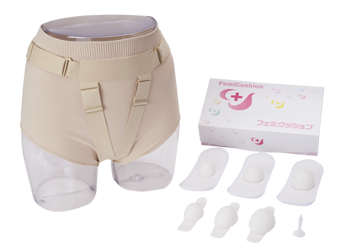
このページの監修医師

このページの監修医師
If you feel discomfort in your abdomen or uterus after giving birth, you are not alone.
https://urogyne.jp/prolapse/postpartum/
Are you feeling anxious about changes in your body after childbirth, such as a sense of openness in your vaginal area or discomfort in your lower abdomen? Many women experience these sensations due to the natural weakening of the pelvic floor muscles, which support the pelvic organs, during pregnancy and childbirth. This feeling of openness could be a sign of pelvic organ prolapse, specifically uterine prolapse, where the uterus descends from its normal position. In this article, we will discuss postpartum uterine prolapse, a common concern for many women, covering its symptoms, causes, and treatment options. Left untreated, prolapse can worsen, so please read on to learn how to prevent progression and seek timely medical attention.
Uterine prolapse occurs when the uterus descends into the vagina, sometimes even protruding outside the body. While various factors contribute to this condition, pregnancy and childbirth pose a significant risk. For a deeper dive into uterine prolapse, refer to our article “Uterine Prolapse: Is Self-Treatment and Reversal Possible?”
Initial symptoms often include a feeling of pressure or a sensation of something touching the inside of the vagina when sitting. As the condition progresses, it may lead to urinary incontinence, pain, and bleeding. For more information on the symptoms of uterine prolapse, see our article “Feeling a Descent in Your Uterus or Bladder? Suspected Conditions to Consider.”
Uterine prolapse is primarily caused by the weakening or damage of the pelvic floor muscles, which support the pelvic organs, including the uterus, bladder, and rectum. When these muscles weaken or are injured, they can no longer adequately support the organs, leading to prolapse.
Several factors can contribute to pelvic floor muscle weakening or damage, including:
* Childbirth (vaginal delivery, difficult labor, multiple births)
* Aging and menopause
* Obesity
* Chronic constipation with straining during bowel movements
* Weak constitution
* Chronic cough (bronchitis, asthma)
* Prolonged standing
* Heavy lifting
* Pelvic surgery
Childbirth is the most common cause. Women who have had multiple vaginal deliveries or have given birth at an older age are at a higher risk. While uterine prolapse rarely occurs immediately after childbirth, symptoms often manifest later in life, typically after menopause (around 50-60 years old). However, in rare cases, it can occur soon after delivery.
The increased prevalence after menopause is attributed to the decline in estrogen levels, which weakens the support structures of the pelvic floor muscles.
Obesity, constipation, chronic coughing, prolonged standing, and heavy lifting can increase abdominal pressure, contributing to uterine prolapse. Previous pelvic surgery may also damage the pelvic floor muscles, making them more susceptible to weakening with age and increasing the risk of prolapse.
Pregnancy and childbirth are significant risk factors for uterine prolapse. During pregnancy, the growing baby increases abdominal pressure, placing continuous strain on the pelvic floor muscles.
During childbirth, the baby passes through the birth canal, potentially stretching and weakening the pelvic floor muscles. Factors such as a larger baby (over 3,500 grams), prolonged labor, assisted deliveries (forceps or vacuum), advanced maternal age, and smoking during pregnancy further increase the risk.
While symptoms typically appear after menopause (around 50 years old), they can also arise soon after childbirth.
Uterine prolapse can cause discomfort during intercourse, but it does not necessarily preclude pregnancy. If you desire to have children, non-surgical treatment options like pessaries can be considered. In younger women, pessary use can often resolve the prolapse within a few months and allow for comfortable intercourse.
While a smooth and swift delivery is ideal, it’s not always within our control. After childbirth, diligently practicing pelvic floor exercises (Kegels) is crucial to strengthening the weakened muscles. If you experience any discomfort in your lower abdomen or develop uterine prolapse, seek early intervention with treatments like pessaries to prevent progression.
Regular pelvic floor muscle training (Kegel exercises) can effectively prevent uterine prolapse. Maintaining a healthy weight, eating a balanced diet, staying hydrated, and engaging in regular exercise can also help prevent constipation, which is another contributing factor.
Mild cases may improve with pelvic floor muscle training. However, if part or all of the uterus has prolapsed, the following treatments are commonly used:
A device inserted into the vagina to support the uterus and prevent further prolapse. Regular medical check-ups and pessary replacements are necessary to avoid complications such as inflammation and bleeding.
This external device supports the prolapsed organs by applying gentle pressure to the vaginal opening. It is comfortable to wear, reusable, and feels like underwear. https://www.femicushion.com/
Surgical intervention is recommended for severe cases or when a permanent solution is desired. Options include transvaginal mesh surgery (TVM), vaginal hysterectomy with pelvic floor repair, vaginal closure surgery, laparoscopic sacrocolpopexy (LSC), and robotic-assisted sacrocolpopexy (RSC).
FemiCushion offers a non-invasive, body-friendly treatment option for women who cannot undergo surgery or prefer to avoid internal devices. It is widely recommended by healthcare professionals and gynecologists.

永尾 光一 先生
東邦大学 医学部教授(泌尿器科学講座)
東邦大学医療センター大森病院 リプロダクションセンター
東邦大学医療センター大森病院 尿路再建(泌尿器科・形成外科)センター長
昭和大学にて形成外科学を8年間専攻。その後、東邦大学で泌尿器科学を専攻し、形成外科・泌尿器科両方の診療科部長を経験する(2つの基本領域専門医を取得)。得意分野はマイクロサージャリーをはじめとする生殖医学領域の形成外科的手術。泌尿器科医の枠を超えた細やかな手術手技と丁寧な診察で、様々な悩みを抱える患者さんから高い信頼と評価を得ている。
所属医療機関

株式会社三井メディカルジャパン 代表取締役
三井 桂子
株式会社三井メディカルジャパン 代表取締役。日本における女性疾患についての認知や理解度の低さに危機感をおぼえ、医療機器開発に着手。子宮脱をはじめとする骨盤臓器脱の治療に用いる「フェミクッション」を開発し、三井メディカルジャパンを通じて発売。
スターターキット ライトネット購入限定

まずは試してみたい
という⽅に!
セット内容
・サポーター1枚(ミディベージュサポーター)
・クッション 3個(S・M・L各サイズ1個)
・布製ホルダー(フリーサイズ3枚)
・洗浄栓
※スターターキット ライトをご選択の方はミディベージュサポーターのみとなります。
スターターキット

普段の⽣活でしっかり
使いたい⽅に!
セット内容
・サポーター1枚(次の項目で種類・サイズを選択ください)
・クッション 6個(S・M・L各サイズ2個)
・布製ホルダー(フリーサイズ3枚)
・洗浄栓
※コットンの特注サイズは現在在庫切れです。